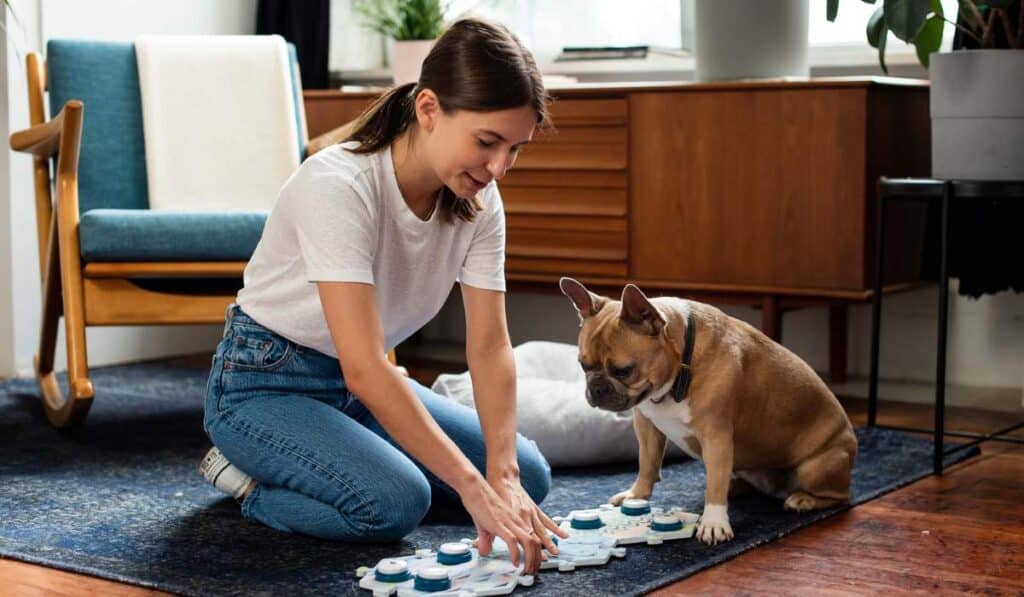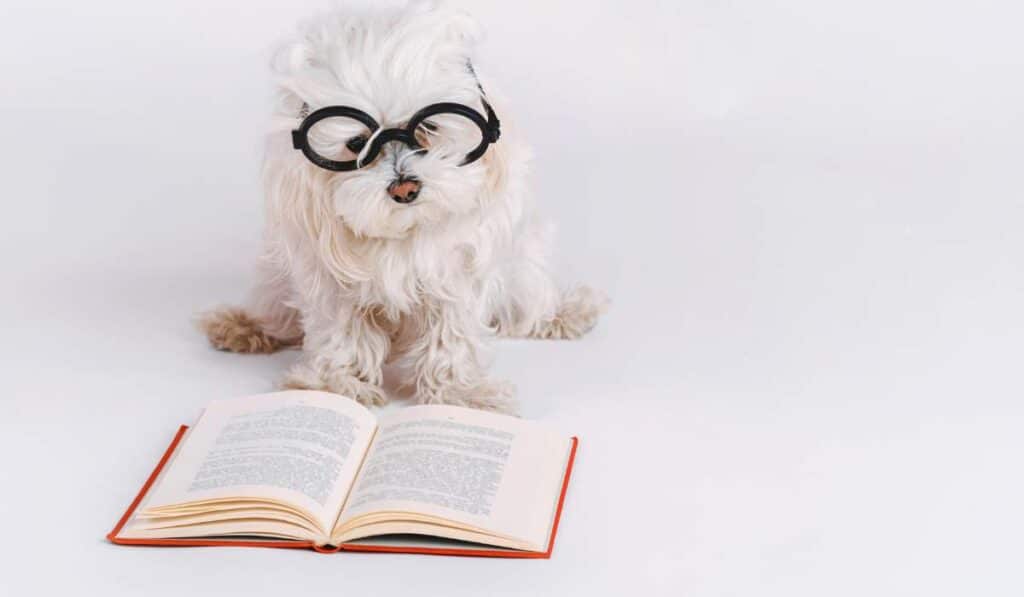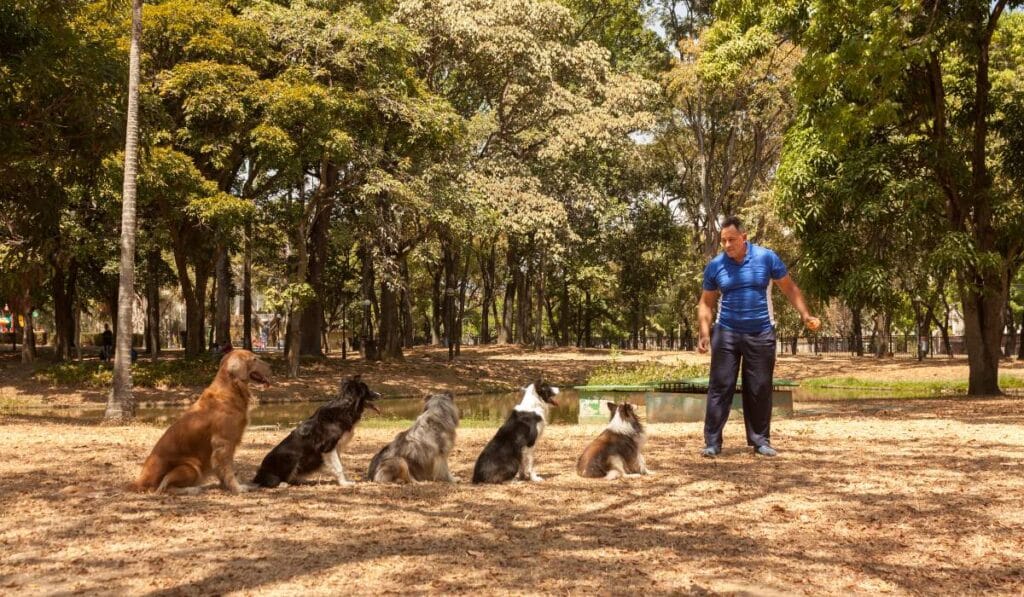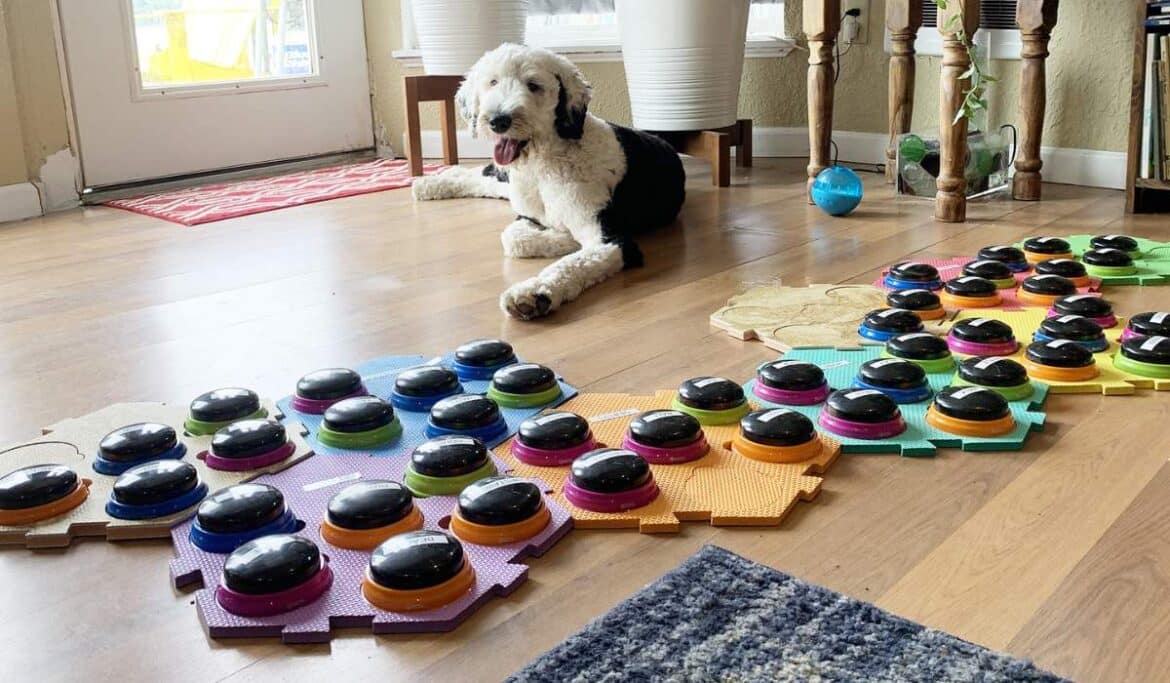Have you ever wished that your furry friend could talk to you? While we can’t teach dogs to speak our language, we can now use technology to help them communicate with us. Enter dog talking buttons – a revolutionary tool that allows dogs to express themselves through speech-like sounds.
Dog talking buttons are essentially buzzers or recordable buttons that can be programmed with words or actions. By pressing the button, the dog can convey their needs, wants, and emotions. This innovative method of communication has gained popularity in recent years, but it’s not the first attempt at bridging the communication gap between humans and dogs.
Effective communication is crucial in any relationship, including the one with your pet. With dog talking buttons, you can better understand your dog’s needs and strengthen your bond with them.
Understanding the Concept of Dog Talking Buttons

How Dogs Communicate with Humans
Dogs are intelligent animals and can communicate with humans in various ways. They use body language, vocalizations, and facial expressions to convey their emotions and needs. For example, a wagging tail indicates happiness, while growling or barking signals aggression or fear.
However, sometimes dogs may have difficulty communicating effectively with humans. This is where dog-talking buttons come in handy.
The Science Behind Canine Cognition and Language Learning
Studies have shown that dogs possess cognitive abilities similar to those of young children. They have the capacity to learn new words and understand complex concepts through repetition and positive reinforcement.
Through training, dogs can learn to associate specific words with certain actions or objects. This process is known as associative learning. By using dog talking buttons, owners can provide their pets with an expanded vocabulary beyond basic commands like “sit” or “stay.”
Explanation of How Dog-Talking Buttons Work
Dog talking buttons are essentially soundboards that allow dogs to communicate by pressing different buttons that play recorded words or phrases. These buttons can be programmed to say anything from “outside” when they need to go out for a walk, to “play” when they want attention from their owner.
To train your dog to use these buttons, start by introducing them one at a time. When your dog presses the button correctly, reward them with treats or praise. Gradually increase the number of buttons as your dog becomes more proficient at using them.
There are several types of dog-talking button systems available on the market today. Some require manual programming by the owner, while others use artificial intelligence technology that adapts to your pet’s behavior over time.
Different Types of Dog Talking Button Systems Available
- Manual Button Systems – These systems require you to program each button manually using pre-recorded audio files.
- Pre-Programmed Button Systems – These systems come with pre-recorded audio files that are already programmed into the buttons.
- Artificial Intelligence Button Systems – These systems use machine learning algorithms to adapt to your dog’s behavior over time. They can analyze your pet’s vocalizations and create custom responses based on their unique needs.
Benefits of Training Dogs to Use Talking Buttons
Training dogs to use talking buttons has become increasingly popular among pet owners. This training method involves teaching dogs how to communicate using a set of buttons that produce different sounds when pressed. These buttons can be programmed with words or phrases, allowing dogs to express their wants and needs effectively.
Improved Communication between Dogs and Their Owners
One of the most significant benefits of training dogs to use talking buttons is improved communication between pets and their owners. By using these buttons, dogs can let their owners know what they need or want, such as food, water, or playtime. Moreover, it allows for more meaningful interactions between humans and animals. When pets feel understood and heard by their owners, they tend to be happier and more content.
Enhanced Cognitive Development for Dogs
Another benefit of training dogs to use talking buttons is enhanced cognitive development. Studies have shown that this type of training stimulates the dog’s brain and helps them develop better problem-solving skills. It also improves their memory retention since they are required to remember which button corresponds with each word or phrase.
Increased Bonding between Pets and Their Owners
Training your dog to use talking buttons can also lead to increased bonding between pets and their owners. This type of training requires patience, consistency, and positive reinforcement techniques from pet parents. As a result, it strengthens the bond between humans and animals through regular interaction.
Potential for Better Behavior Management in Dogs
Lastly, there is potential for better behavior management in dogs who are trained with talking buttons. By communicating their needs effectively through these devices, pets may be less likely to engage in destructive behaviors such as chewing on furniture or barking excessively.
Can any dog learn to use talking buttons?

Dogs are incredibly intelligent creatures that can be trained to do a variety of tasks, including using communication devices. However, not all dogs have the same ability to learn new skills, and some breeds may be more predisposed to excel at certain types of training.
Factors that determine a dog’s ability to learn new skills
There are several factors that can influence a dog’s success. These include:
- Intelligence: Some dogs are simply smarter than others and may have an easier time learning complex tasks.
- Trainability: Certain breeds are known for being highly trainable and responsive to commands.
- Age: Puppies have a greater capacity for learning than older dogs, but older dogs can still be taught new things with patience and persistence.
- Personality: Dogs with outgoing personalities may be more willing to try new things and experiment with communication devices.
Breeds that are more likely to excel at using talking buttons
While any breed of dog can potentially learn how to use talking buttons, some breeds may be better suited for this type of training. Here are a few examples:
- Border Collies: These highly intelligent dogs are known for their problem-solving abilities and eagerness to please their owners.
- German Shepherds: Another breed that is renowned for its intelligence and trainability, German Shepherds make excellent service animals due in part to their ability to understand human language cues.
- Poodles: Standard Poodles in particular are often used as therapy dogs due in part to their high level of intelligence and willingness to communicate with humans.
Age limitations for teaching dogs new tricks or skills
While puppies have a greater capacity for learning than older dogs, there is no age limit. Older dogs may take longer to learn new things, but with patience and persistence, they can still be trained to use communication devices like talking buttons.
Tips for identifying if your pet is a good candidate for learning how to use a button system
If you’re interested in teaching your dog how to use talking buttons, there are a few things you can look for to determine if they might be a good candidate
By considering these factors and taking the time to train your dog properly, you may be able to successfully teach them how to communicate with you using a button system.
Setting up your dog’s button system for optimal learning
Choosing the right type of button system based on your needs and budget
Training your pup to use dog-talking buttons is an exciting process that requires some initial investment. You must consider various factors such as size, durability, sound quality, and price.
There are two types of button systems available in the market: programmable and pre-programmed. Pre-programmed buttons come with fixed words or phrases that may not be customizable. In contrast, programmable buttons allow pet parents to record their own voices or sounds and assign them to specific buttons.
When selecting a button system, you must also consider your budget. Pre-programmed systems are generally less expensive than programmable ones. However, if you’re looking for customization options and want to create personalized signals for your pup, then investing in a programmable button system might be worth it.
Placement considerations when setting up the button system in your home
Once you’ve chosen the right type of button system for your furry friend, you need to decide where to place them in your home. It’s essential to choose a location that is easily accessible by your pet so they can press the buttons whenever they need attention or want to communicate with you.
The placement of the buttons should be consistent throughout the house so that your pet can associate each signal with its corresponding activity or need. You should also ensure that there is enough space between each button so that your pet doesn’t accidentally hit more than one at once.
Best practices for introducing the button system to your pet
Introducing a new tool like a dog talking button can be overwhelming for pets initially. Therefore, it’s crucial to start slow and gradually introduce them to the concept.
Start by placing one or two buttons near their food bowl or play area and using them consistently while rewarding positive behavior with treats or praise. Once they start associating the signals with their needs, you can add more buttons and expand their vocabulary.
It’s also essential to pay attention to your pet’s learning style. Some learners respond better to verbal cues while others prefer visual aids. You can use a combination of both by placing pictures or symbols near each button that represents its corresponding activity.
Tips on maintaining the equipment and troubleshooting potential issues
To ensure that your dog talking button system lasts long and functions correctly, you must maintain it regularly. Here are some tips for maintenance:
- Clean the buttons regularly using a damp cloth or disinfectant wipes.
- Check the battery life frequently and replace them when needed.
- Keep the buttons away from moisture or direct sunlight.
In case you face any issues with the system, such as unresponsive buttons or sound quality problems, try troubleshooting by checking the batteries or resetting the device. If these steps don’t work, contact customer support for further assistance.
Step-by-step guide on how to train your dog to use talking buttons

Pre-training preparations
Before starting the button training, you need to identify keywords and phrases that your dog will learn. These words can be anything from “outside” to “water.” Make sure you have a clear understanding of what each word means and how it will be used.
It’s also important to ensure that your dog has mastered basic commands such as “sit,” “stay,” and “come.” These commands will come in handy during the training sessions, as they teach your dog discipline and obedience.
Techniques used during training sessions
The most effective technique for button training is positive reinforcement. This involves rewarding your dog with treats or praise every time they correctly press a button. It’s important to start with one button at a time, using repetition until your dog understands what each word means.
Another technique is modeling, where you demonstrate how to use the buttons by pressing them yourself. Your dog will observe this behavior and eventually mimic it.
Gradual progression toward advanced communication
Once your dog has mastered the basics, you can gradually introduce more advanced communication through the button system. This involves teaching them new words and phrases over time and building up their vocabulary.
To help reinforce their learning, make sure to regularly practice with them during daily activities such as mealtime or walks. Encourage them to use their buttons whenever possible so that they become comfortable communicating through them.
Additional tips for successful training
- Be patient: Button training takes time and effort, so don’t get discouraged if progress is slow.
- Keep sessions short: Dogs have a short attention span, so try to keep each session under 10 minutes.
- Use high-value rewards: Treats or toys that your dog loves can be great motivators during training.
- Consistency is key: Try to maintain a consistent routine throughout the training process.
- Monitor progress: Keep track of your dog’s progress and adjust the training accordingly.
Button training can be a fun and rewarding experience for both you and your furry friend. With patience, consistency, and positive reinforcement, your dog will soon be communicating with you through their buttons.
Common Mistakes and Troubleshooting Tips
Common mistakes made by pet owners during training sessions
Training your dog to use a button system can be challenging, especially if you are a new pet owner. However, some common mistakes could make it even more difficult for your furry friend to learn. Here are some of the most common errors that pet owners make when teaching their dogs how to use buttons:
- Inconsistent training: One of the biggest mistakes that pet owners make is being inconsistent with their training. Dogs need repetition to learn, and if you skip training sessions or don’t follow through with commands, your dog will struggle to understand what you want them to do.
- Not starting with basics: Another common mistake is not starting with basic commands before moving on to more complex ones. Your dog needs to understand simple commands like “sit” and “stay” before it can learn how to use buttons effectively.
- Not rewarding good behavior: Dogs respond well to positive reinforcement, so it’s essential to reward good behavior during training sessions. If you only focus on what your dog is doing wrong, they may become discouraged and lose interest in learning.
Troubleshooting common problems encountered while using a button system
Even after consistent training, there may be some issues that arise when using a button system with your dog. Here are some troubleshooting tips for common problems:
- Button confusion: If your dog seems confused about which button to press, try labeling each button with a picture or word that corresponds with the action you want them to take.
- Lack of interest: If your dog seems disinterested in using the buttons, try changing up the rewards you give them for successful button presses. Some dogs respond better to treats than verbal praise.
- Button malfunction: If one of the buttons stops working correctly, replace it immediately. It’s essential not to let any technical difficulties hinder your dog’s progress.
Tips on how to overcome challenges faced while teaching your pet
Training your dog to use a button system takes time and patience. Here are some tips on how to overcome the challenges you may face during the training process:
- Be consistent: Consistency is key. Set aside time each day for training sessions, and try to stick to a routine as much as possible.
- Start with basics: Begin by teaching your dog simple commands like “sit” and “stay” before moving on to more complex ones like using buttons.
- Keep it fun: Dogs respond well to positive reinforcement, so make sure that training sessions are enjoyable for both you and your furry friend. Use treats, toys, or verbal praise as rewards for good behavior.
- Don’t get discouraged: Remember that every dog learns at their own pace. If your pet seems to be struggling with the button system, take a break and come back to it later.
By avoiding common mistakes, troubleshooting problems quickly, and following these tips, you’ll be well on your way to successfully training your dog to use a button system. With patience and persistence, you’ll have a furry friend who can communicate with you in no time!
Questions About Teaching Dogs to Communicate with Buttons

What are the common questions asked by pet owners when starting to use a button system?
Teaching dogs how to communicate with buttons can be an exciting and rewarding experience. However, as a pet owner, you may have several questions regarding the process of training your dog to use these buttons. Some common questions asked by pet owners include:
- How do I introduce my dog to the button system?
- How many buttons should I start with?
- How long does it take for a dog to learn how to use the buttons?
- Can all dogs learn how to communicate using buttons?
What are the answers to frequently asked questions about training and using the button system?
Introducing your dog to a button system requires patience, consistency, and persistence. Here are some answers to frequently asked questions that may help you in this journey:
How do I introduce my dog to the button system?
The first step is introducing your dog to each button one at a time. Begin by pressing one of the buttons yourself while saying its corresponding word out loud (e.g., “outside” or “play”). Repeat this process for each button until your dog becomes familiar with them.
How many buttons should I start with?
It’s best to start with just a few basic words such as “food,” “water,” and “outside.” As your dog becomes more comfortable using these buttons, you can gradually add more words.
How long does it take for a dog to learn how to use the buttons?
Every dog is different, so there is no set timeline for learning how to use the button system. However, most dogs can begin communicating simple requests within just a few weeks of consistent training.
Can all dogs learn how to communicate using buttons?
While not every dog will be able or willing to learn how to use communication buttons, most can benefit from this type of training. It’s important to remember that dogs have their own unique personalities and learning styles, so some may take longer than others to learn.
What are additional resources for further information on teaching dogs how to communicate with buttons?
If you’re interested in learning more about teaching your dog to use communication buttons, there are several helpful resources available:
- YouTube channels such as “Hunger4Words” and “Talking Dogs” offer videos of dogs using communication buttons.
- Books such as “The Learning Dog: Clicker Training for Dogs” by Diane Bauman provide detailed instructions on how to train your dog using positive reinforcement techniques.
- Working with a professional trainer or language pathologist who specializes in animal communication can also be a valuable resource.
Conclusion
Training your dog to use talking buttons can be a fun and rewarding experience for both you and your furry friend. By understanding the concept of dog-talking buttons, setting up the button system correctly, and following a step-by-step guide, any dog can learn to communicate using buttons.
The benefits of teaching your dog to use talking buttons include improved communication, increased mental stimulation, and strengthened bonds between you and your pet. However, it’s important to avoid common mistakes during training and troubleshoot any issues that arise.
If you’re interested in teaching your dog how to communicate with buttons, start by researching different button systems available on the market. Once you’ve found one that suits you and your dog’s needs, follow the provided instructions carefully to ensure optimal learning.
Remember that every dog is unique and may require different approaches. Be patient, consistent, and always reward good behavior.
Frequently Ask Questions (FAQs)
How long does it take for a dog to learn how to use talking buttons?
The time it takes for a dog to learn varies depending on their age, breed, personality, and previous training experience. Some dogs may pick up the concept quickly within a few weeks while others may take several months of consistent training.
Can older dogs learn how to use talking buttons?
Yes! Dogs of all ages can learn new things with patience and consistency. However, older dogs may take longer than younger ones due to their decreased ability to hear or see.
What are some common mistakes when training dogs with talking buttons?
Common mistakes include not being consistent with button placement or language used, not rewarding good behavior enough or at all, and moving too fast through the training process without allowing enough time for reinforcement of each step.
Can I teach my deaf dog how to use talking buttons?
Yes! There are visual cue options available such as flashing lights or vibrating buttons that can be used to communicate with deaf dogs.
Are there any risks associated with using talking buttons for dogs?
No, there are no risks associated with using talking buttons for dogs. However, it’s important to supervise your dog during training and ensure they do not chew on or ingest the buttons.

